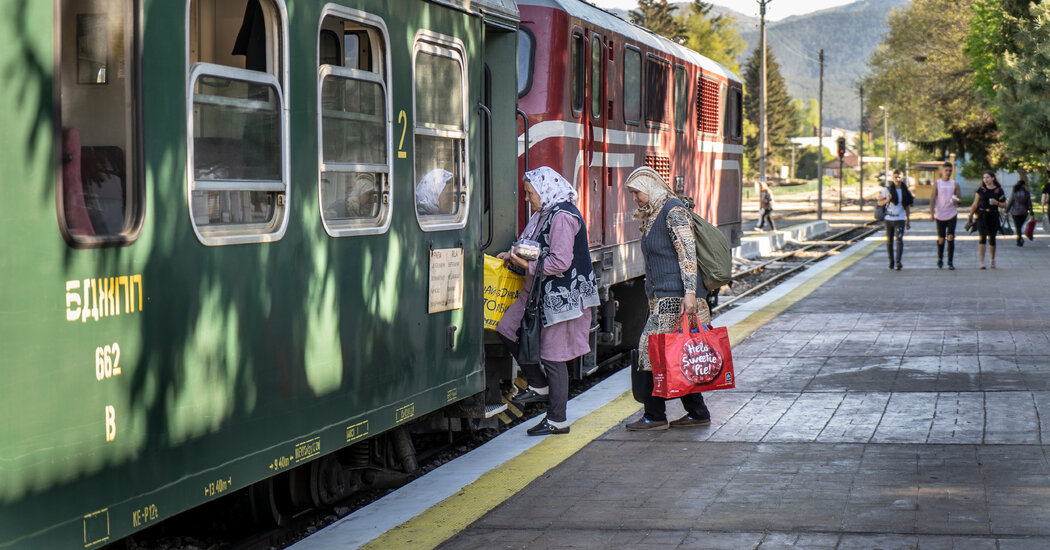

Dressed in a floral-patterned tunic and baggy pants, her hair covered with a colorful head scarf, Sabie Djikova loaded a dozen bottles — 45 pounds’ worth of milk — into a knapsack and a handmade bag, heaved them over her narrow shoulders and headed down the unpaved road toward the nearby train station.
At 65, she carries less than she used to. “When I was younger, I could carry up to 40 kilos,” she said — nearly 90 pounds.
Sabie and her family are part of a small community of Pomaks, Bulgarian-speaking Muslims who have lived for hundreds of years in a remote, mountainous region of the country. As with others in her village, Sabie owns a few dairy cows, which she milks each day before dawn.
For more than 20 years, Sabie has made the daily trek from her village of Ablanitsa to the nearby Tsvetino station, where a small train then carries her about 30 minutes to the market town of Velingrad. There, she goes house to house delivering bottles of fresh, unpasteurized milk. Other Ablanitsa women sell their products, including cheese, yogurt and honey, at the Velingrad open market.
The little money the sellers make helps provide for their intergenerational families. None of their business would be possible without the train, which is the most practical way for them to bring their goods to the market.
I first met Sabie in 2019, when, on a trip with friends, I saw her — among a group of traditionally dressed Pomak women — boarding the train in Velingrad. After we spoke for a few minutes (my friend Ogy Kovachev translated), I got the idea to photograph her daily rituals as a way of showing how important the train line is to the villagers who depend on it to sell their products.
Ogy, who often rode the train for the sheer pleasure of it and who liked to buy milk from Sabie, helped me to connect with her, and I planned to return to photograph her soon. But between the pandemic and my obligations teaching photojournalism, our meeting was delayed for nearly two years.
Finally, this past May, my Bulgarian husband and I took the train to Ablanitsa. The village is home to a few hundred people who live along dirt roads on a steep hill. From the top of the village, you can breathe the crisp mountain air and see clear across the valley to the nearby peaks of the Rhodope Mountains. There was once a rug-making factory here, along with a school and a medical clinic, but all those are gone now. There are no shops or restaurants. The only public building is a small mosque that was locked when I walked past.
Sabie welcomed me with a warm embrace. Her grown son, Musa, brought chairs into the yard, and her daughter-in-law followed, carrying glasses of homemade ayran and a massive jar of blueberry juice. (The Pomaks are known for making products from the wild blueberries they collect.) Musa showed us the barn that houses two cows, a calf and a horse. He also showed us the rest of the little homestead, where the family raises rabbits and chickens.
Although modest and a bit shy, Sabie eventually agreed to let me photograph her daily routine. In following her, I got a better understanding of just how important the train is to local residents.
The Rhodope Narrow-Gauge Railway serves 27 stations across the Rhodope mountain range. Built in the first half of the 20th century, the railway has a track with a width of 760 millimeters, or around 30 inches, which is roughly half the width of a standard railroad track. (The narrow gauge is good for climbing steep terrain and allows for tighter curves, lighter rail and smaller tunnels — all of which are critical to its route through the mountains.)
At one time, dozens of narrow-gauge train lines crisscrossed Bulgaria, helping to connect small villages with important trading towns. After the collapse of Communism, ridership declined as large numbers of villagers migrated out of the countryside. As the country suffered through economic crises, the Bulgarian National Railways disinvested in the narrow-gauge lines.
Today, the Rhodope Narrow-Gauge Railway is the last of its kind in the country. But its continued existence is in jeopardy. At one point the track conditions were so dire that the train traveled painfully slow. “You could walk beside it at the same speed or faster,” said Ivaylo Mehandzhiev, 27, a member of the nonprofit group Za Tesnolineikata, which means “For the Narrow Gauge.”
Beginning at Septemvri Station, the line’s northern terminus, the track follows the course of the Chepinska and Ablanitsa rivers. It passes through a scenic gorge until it peels away and ascends a forested slope, making a hairpin turn followed by a spiral and then a figure eight. It continues to climb toward the village of Avramovo. (At 4,157 feet, Avramovo is the highest train station on the Balkan Peninsula; it offers wide open views toward the snow-capped Pirin Mountain peaks.) From there, the track heads downhill toward the ski resort towns of Bansko and Dobrinishte. In total, the trip covers 78 miles, takes about five hours and costs 6.60 Bulgarian levs, or about $4.
Sabie pays just 54 Bulgarian levs ($32) for a pensioner’s trimonthly pass, making it a very affordable form of transportation.
The railway has long faced the threat of closure. Ridership is low. Maintenance costs are high. In recent years, newly built asphalt roads have made travel between villages in the area easier for those who own cars.
Still, the railway provides a valuable and affordable service for many local residents. “The train gave our community access not just to education, but to jobs and hospitals,” said Fatima Ismail, who grew up in Avramovo and, as a teenager, took the train to high school. And it contributed to teenage romance, she said, blushing as she remembered a boy who used to take the train from Tsvetino and meet her at the station.
It has also provided local employment. Fatima’s cousin, Mehmet, was a station manager, and two other cousins were engineers.
Kristian Vaklinov, now 26, was a teenage train enthusiast when, in 2014, he first learned that the government was considering closing the Rhodope Narrow-Gauge Railway. He responded by organizing and circulating a petition to save the train line. To his surprise, he collected more than 11,000 signatures in just 30 days.
Along with friends like Ivaylo, he formed Za Tesnolineikata, the nonprofit organization; its goal was to save the train by increasing ridership on the line, mainly through tourism.
“The train has a social function,” Kristian explained to me. “It belongs to the people and is our national treasure.”
In order to attract tourists and increase ridership, the group built a website where they posted train schedules, photos and a history of the line (in both English and Bulgarian). They created a museum in one of the stations and filled it with old photographs and historical artifacts. Special event trips are organized on holiday weekends, and people can book a special train ride for their wedding.
This year, to mark the 100th anniversary of the initial construction of the rail line, the group organized a special trip between Septemvri and Velingrad, with five train cars pulled by an antique, coal-powered steam engine. Folk singers performed along the way; the cars were packed with tourists and train enthusiasts.
Despite the line’s popularity, anxieties linger about its future. In particular, the new asphalt roads make some people wonder how much longer the train will continue to run. While some locals are happy with the new roads, others, including women like Sabie who don’t drive, continue to ride the train.
Sabie and the others who travel daily to Velingrad may be the last of their kind. “The older women work really hard,” said Hatije Mircheva, a 58-year-old resident of Ablanitsa, who also sells dairy products at the Velingrad market. But the younger generation? They have other priorities, other routines, she said.
And yet the young train enthusiasts, including the members of Za Tesnolineikata, may be the rail line’s only hope for survival. In fact, they’re already planning a celebration five years from now, in 2026 — with singers and dance groups at every station.
“We hope to keep it running until then,” Ivaylo said.
Jodi Hilton is a photojournalist and documentary photographer based in Boston. You can follow her work on Instagram and Twitter.



